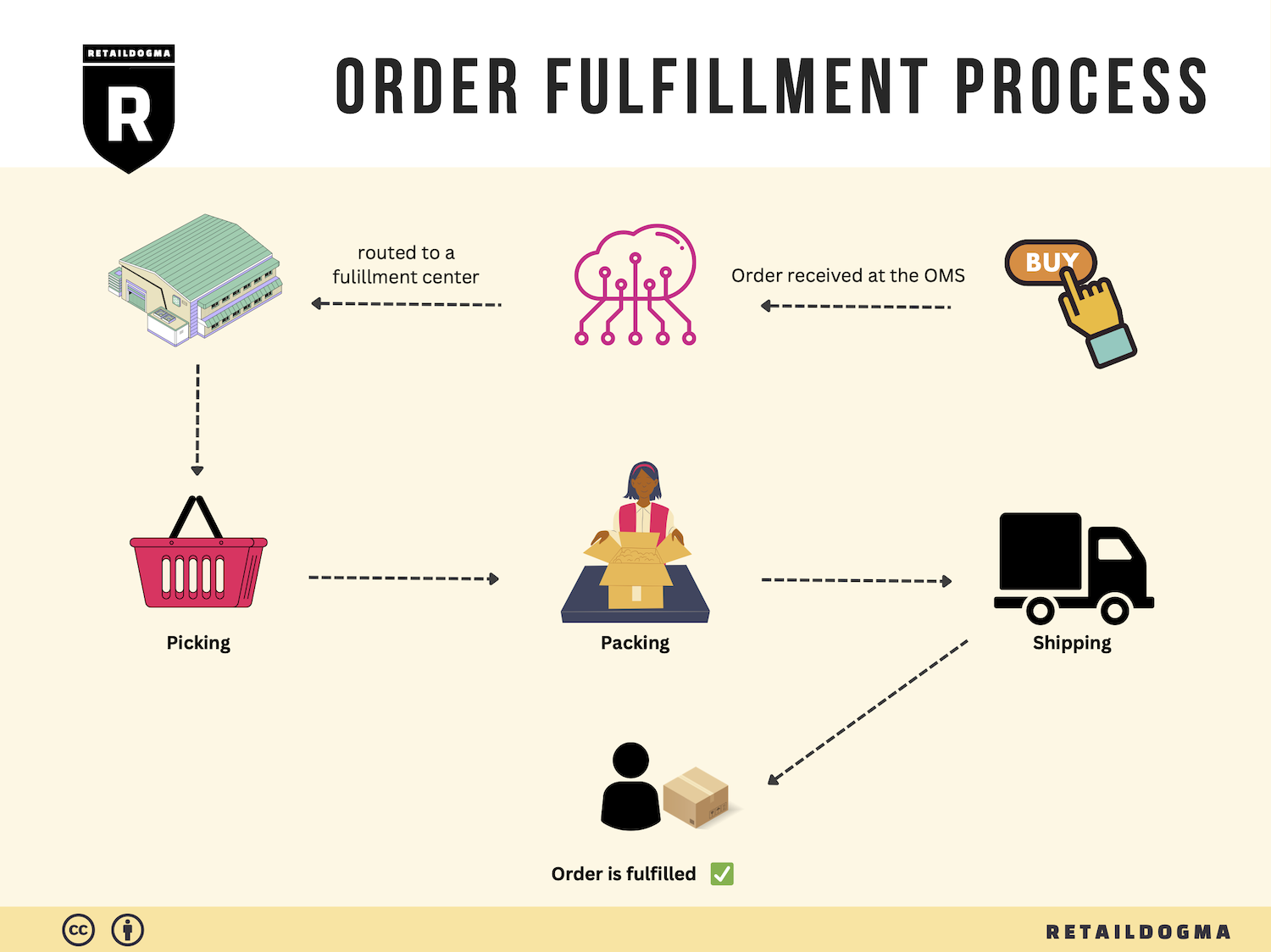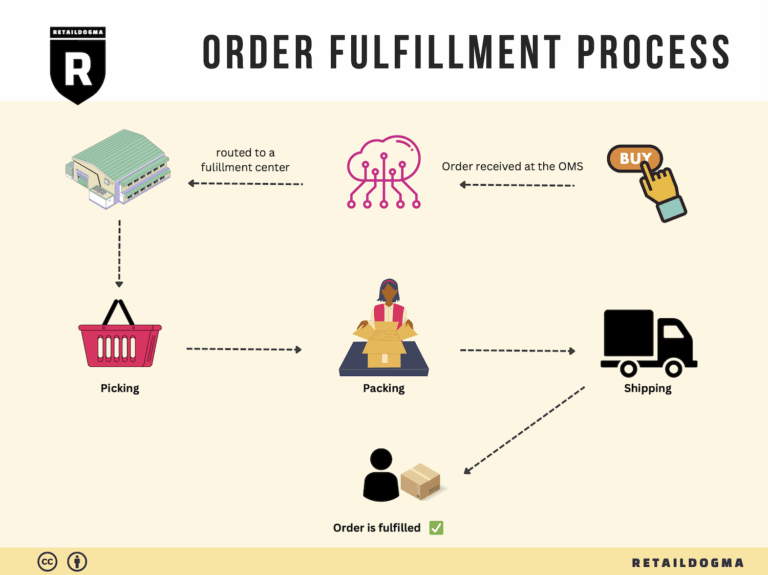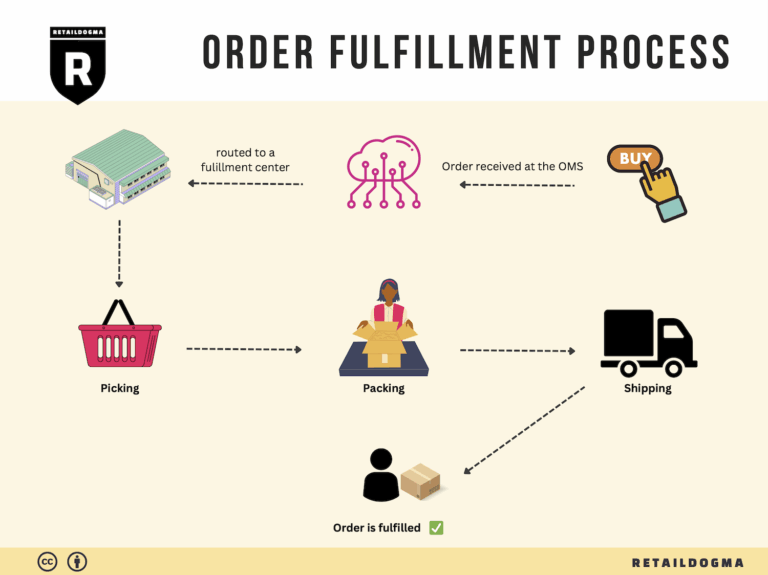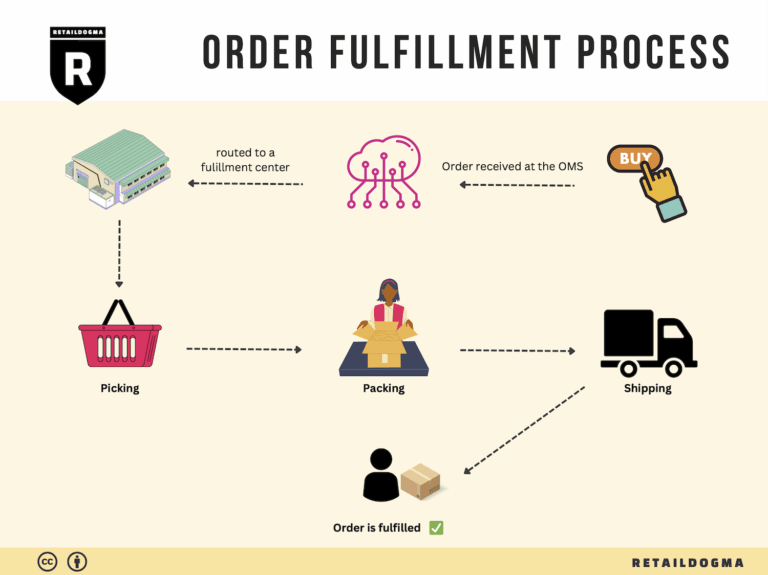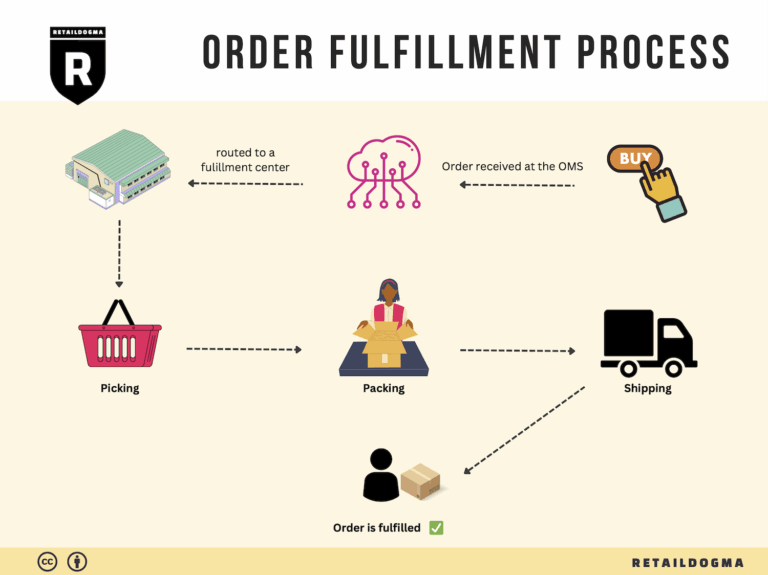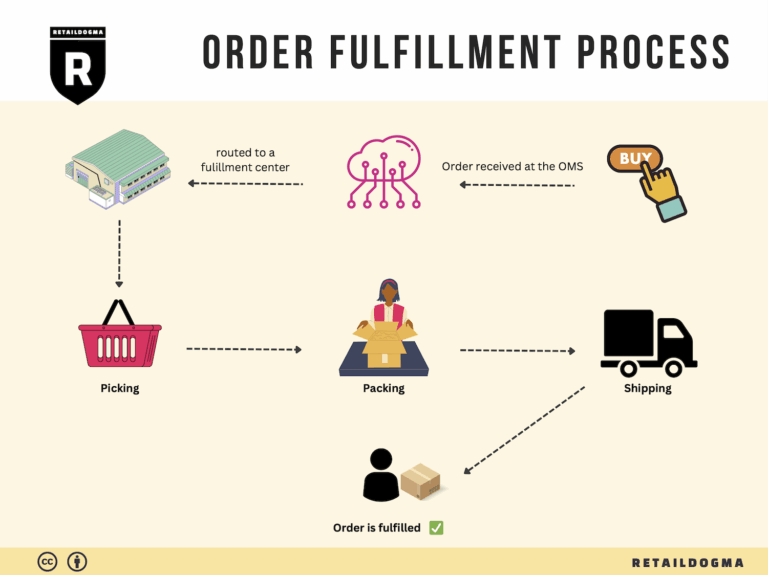How Order Fulfillment Works: A Step-by-Step Guide for Businesses
What is E-commerce Fulfillment? An Introduction for Growing Businesses
Understanding the Fulfillment Challenge
For many growing e-commerce businesses, the excitement of expanding sales can quickly turn into a daunting challenge. As orders increase, so do the complexities of packing and shipping. Business owners often find themselves overwhelmed by the logistics of getting products to customers on time while maintaining quality and efficiency. This is where the concept of e-commerce fulfillment comes into play.
What is E-commerce Fulfillment?
E-commerce fulfillment refers to the entire process of receiving, processing, and delivering orders to customers. It encompasses everything from inventory management and order processing to shipping and returns. In a nutshell, effective fulfillment is about ensuring that the right products reach the right customers at the right time.
What This Guide Covers
In this guide, we will explore the various models of e-commerce fulfillment, including Fulfillment by Amazon (FBA) and Third-Party Logistics (3PL). Each model has unique advantages and considerations, making it essential for business owners to understand their options.
We will delve into the core services offered by fulfillment partners, such as inventory storage, order picking and packing, shipping, and returns processing. Knowing what services are available can help you tailor your fulfillment strategy to meet your specific business needs.
Choosing the right fulfillment partner is another critical aspect we will discuss. Factors such as reliability, scalability, and cost-effectiveness should be considered to ensure you align with a partner that can support your growth ambitions.
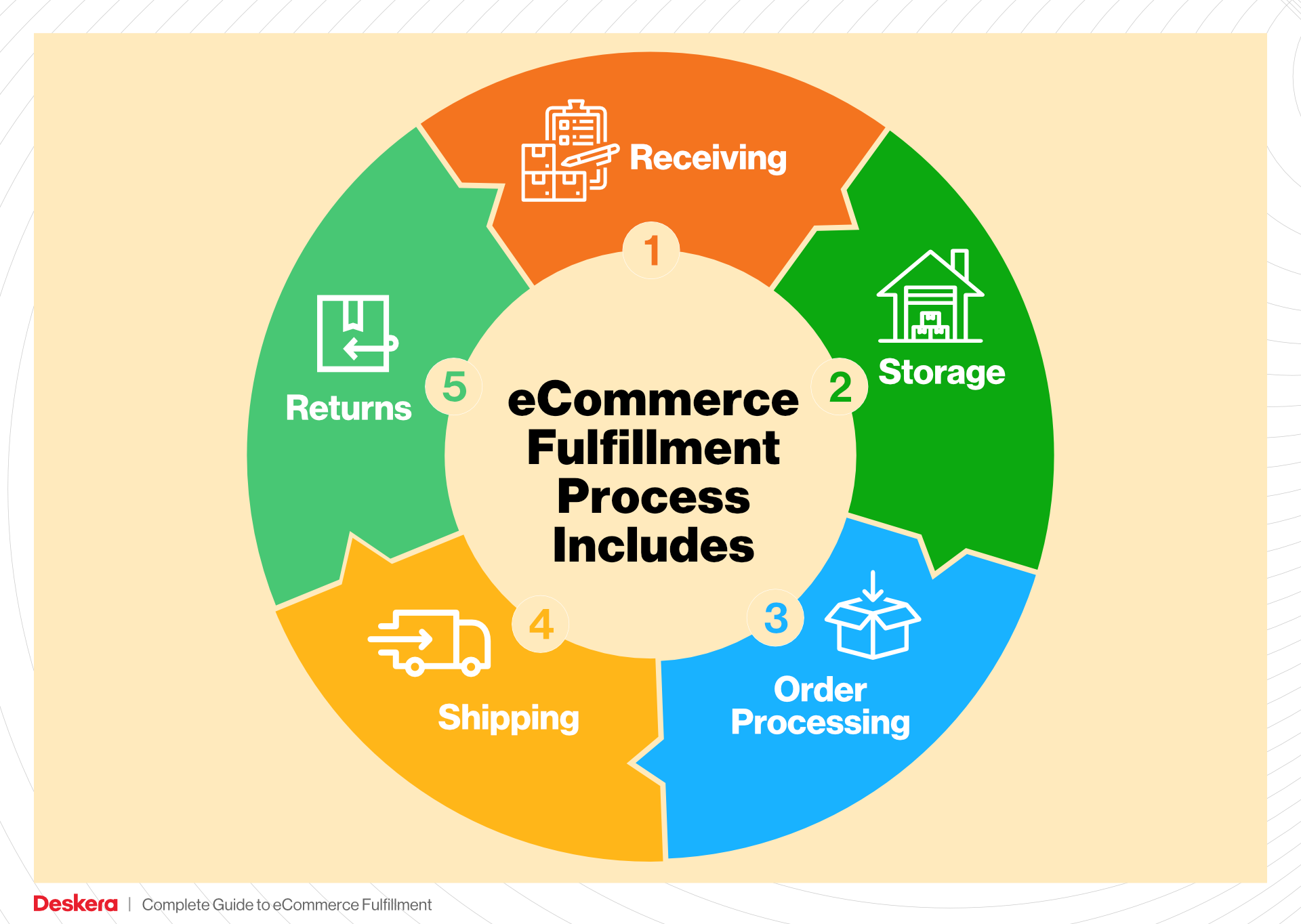
Pricing is a vital component of fulfillment that can significantly impact your bottom line. We will break down the various costs associated with different fulfillment models, including storage fees, shipping costs, and service charges. Understanding these costs will empower you to make informed financial decisions that can enhance your profitability.
Empowering Smart Logistics Decisions
The goal of this guide is to equip e-commerce business owners and operations managers with the knowledge they need to navigate the complexities of fulfillment. By understanding the different options available and how to choose a partner that aligns with your business goals, you can streamline your logistics operations, enhance customer satisfaction, and ultimately drive growth. Whether you’re just starting out or looking to scale your existing operations, this guide will serve as a valuable resource in your e-commerce journey.
What You’ll Learn In This Guide
- What is E-commerce Fulfillment? An Introduction for Growing Businesses
- The Order Fulfillment Process: From ‘Buy’ Button to Customer’s Door
- Comparing Fulfillment Models: In-House vs. 3PL vs. Dropshipping
- A Deep Dive into Amazon FBA: Pros, Cons, and Who It’s For
- Core Services Offered by Fulfillment Centers
- How to Choose a Fulfillment Partner: A 6-Point Checklist
- Understanding Fulfillment Pricing: A Breakdown of Common Fees
- Frequently Asked Questions (FAQs) about Fulfillment
- Conclusion: Is Outsourcing Fulfillment the Right Move for Your Business?
- Important Disclaimer
The Order Fulfillment Process: From ‘Buy’ Button to Customer’s Door
1. Receiving Inventory
The order fulfillment process begins with receiving inventory at the fulfillment center. When products are delivered to Amazon’s warehouses, they undergo inspection to ensure they match the purchase order and are in good condition. Each item is assigned a Stock Keeping Unit (SKU), a unique identifier that facilitates tracking and management throughout the fulfillment process.
Importance: This step is crucial for maintaining inventory accuracy and ensuring that the right products are available for customers. Any discrepancies during this phase can lead to stockouts or excess inventory, both of which can negatively impact sales and customer satisfaction.
Key Term: SKU (Stock Keeping Unit) – A unique identifier for each product that helps in tracking inventory levels and sales.
2. Warehouse Storage
Once the inventory is received and accounted for, it is stored in designated areas within the fulfillment center. Amazon utilizes advanced algorithms to determine the optimal placement of products based on factors such as demand, size, and weight. This strategic storage system not only optimizes space but also enhances the efficiency of the picking process.
Importance: Proper warehouse storage is vital for quick retrieval of items. A well-organized warehouse minimizes the time required to locate products, ultimately speeding up order fulfillment and reducing operational costs.
Key Term: Bin Locations – Specific areas in the warehouse where products are stored, allowing for efficient inventory management and retrieval.
3. Order Picking
When a customer places an order, the next step is order picking. Fulfillment staff use pick lists, which detail the items and their corresponding bin locations, to locate and gather the products needed for the order. Depending on the size and complexity of the order, various picking methods can be employed, such as single order picking or batch picking.
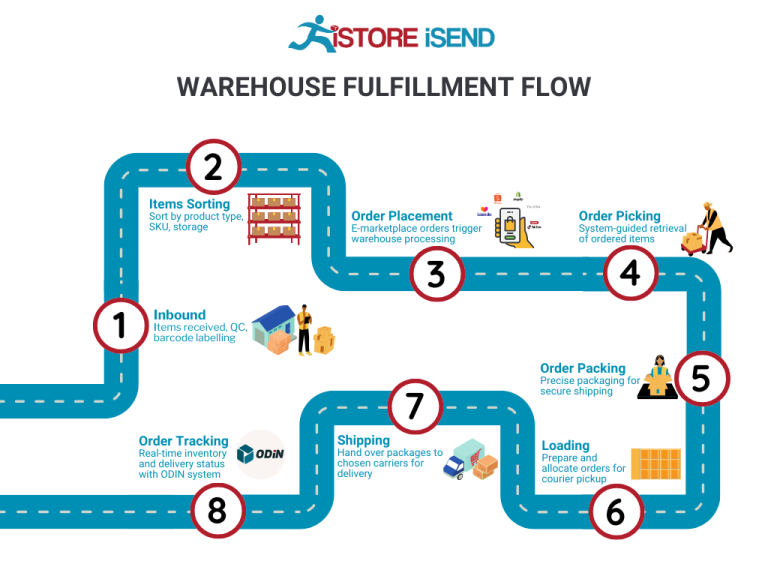
Importance: Efficient order picking is critical to fulfilling customer orders accurately and promptly. Errors during this stage can lead to incorrect shipments, resulting in returns and dissatisfied customers.
Key Term: Pick Lists – Documents that guide fulfillment staff in retrieving items from their storage locations for customer orders.
4. Order Packing
Once the items are picked, they are brought to the packing station, where they are carefully packed for shipment. This step involves selecting appropriate packaging materials, ensuring that products are secure and well-protected during transit. Amazon also utilizes automated systems to streamline packing processes, such as weighing and labeling.
Importance: Proper packing is essential to prevent damage during shipping and to ensure compliance with shipping regulations. Additionally, a well-packed order enhances the customer experience, as it reflects the brand’s commitment to quality.
Key Term: Packing Slip – A document included in the package that outlines the items included in the order, serving as a receipt for the customer.
5. Shipping & Delivery
The final step in the order fulfillment process is shipping and delivery. Once the order is packed, it is handed off to a carrier for delivery. Amazon employs a network of carriers to ensure timely delivery to customers, often utilizing its own logistics solutions like Amazon Prime for expedited shipping options.
Importance: Efficient shipping and delivery are crucial for customer satisfaction. Fast and reliable delivery can significantly enhance the customer experience and encourage repeat business. Moreover, tracking capabilities allow customers to monitor their order status, further improving transparency and trust.
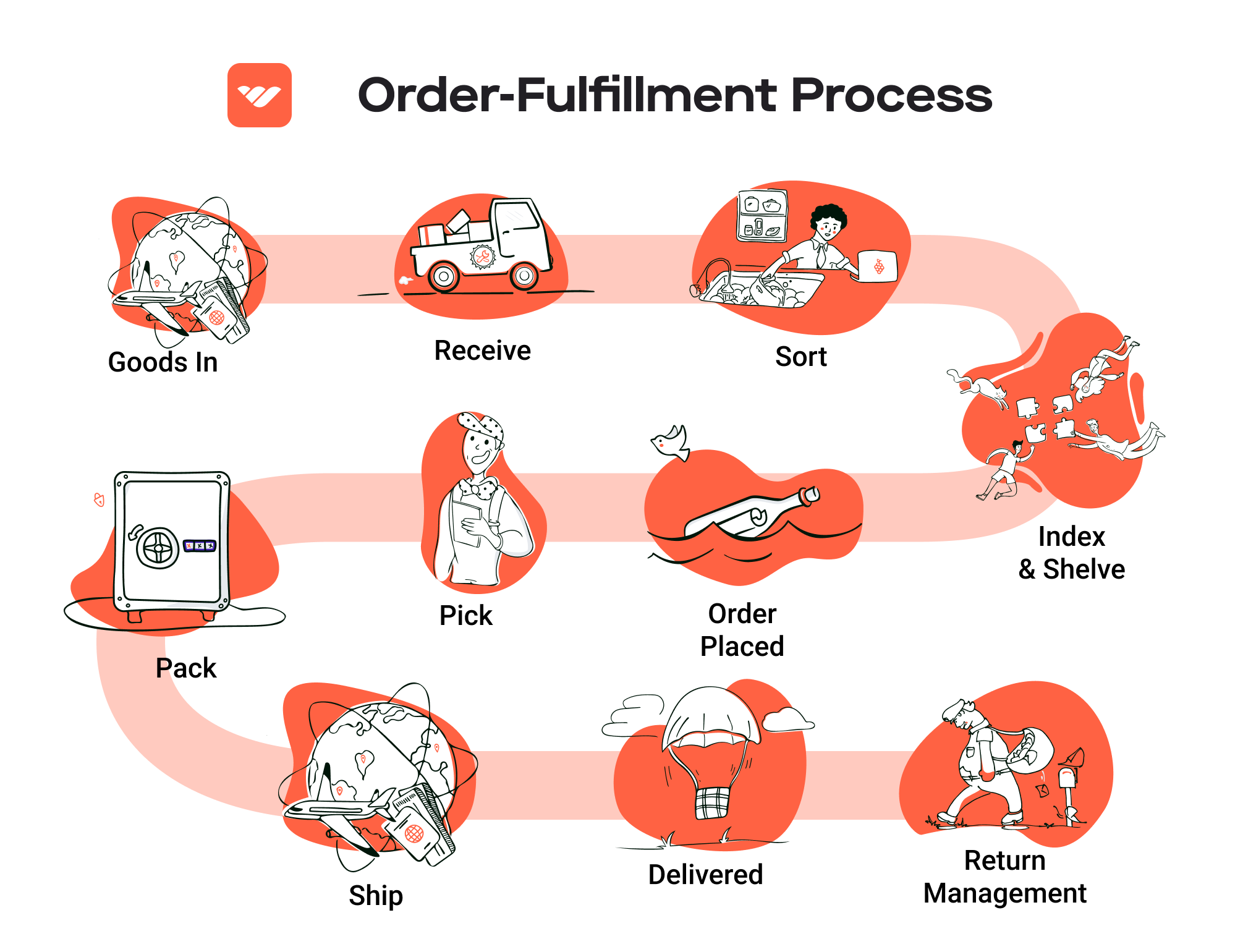
Key Term: Last Mile Delivery – The final step in the shipping process where the package is delivered from a distribution center to the customer’s doorstep, often considered the most critical phase in the logistics chain.
Conclusion
Understanding the order fulfillment process is essential for e-commerce business owners and operations managers aiming to scale their logistics. Each step, from receiving inventory to shipping and delivery, plays a pivotal role in ensuring that products reach customers in a timely and efficient manner. By optimizing these processes and leveraging key terms like SKU, bin locations, pick lists, packing slips, and last-mile delivery, businesses can enhance their fulfillment operations and drive customer satisfaction.
Comparing Fulfillment Models: In-House vs. 3PL vs. Dropshipping
Fulfillment Model Comparison
| Model | Who Handles Inventory | Best For (Business Stage) | Key Advantage | Key Disadvantage |
|---|---|---|---|---|
| In-House Fulfillment | Business itself | Established businesses | Full control over inventory and processes | High overhead costs and resource intensive |
| Third-Party Logistics (3PL) | 3PL provider | Growing businesses | Scalability and expertise in logistics | Less control over inventory and potential service variability |
| Dropshipping | Supplier | Startups and small businesses | Low upfront investment and minimal risk | Lower profit margins and reliance on suppliers |
In-House Fulfillment
In-house fulfillment involves managing all aspects of inventory storage, order processing, and shipping directly within the business. This model is typically best suited for established businesses that have a stable sales volume and sufficient resources to handle logistics operations. The key advantage of in-house fulfillment is the full control it offers over inventory management, order accuracy, and customer service. Businesses can tailor their processes to meet specific needs and maintain a high level of quality control. However, this model can come with significant disadvantages, including high overhead costs related to warehousing, staffing, and shipping. Additionally, it can be resource-intensive, requiring a considerable investment in technology, infrastructure, and workforce management. As a business scales, these operational complexities may hinder growth if not managed effectively.
Third-Party Logistics (3PL)
Third-party logistics (3PL) providers offer a robust solution for businesses looking to scale their operations without the burden of managing logistics in-house. This model is ideal for growing businesses that need flexibility and expertise in logistics management. A key advantage of utilizing a 3PL is the ability to scale operations quickly; businesses can leverage the provider’s infrastructure and expertise to handle increased order volumes without significant capital investment. Additionally, 3PL providers often have established relationships with carriers and can negotiate better shipping rates, which can help reduce overall logistics costs. However, a major drawback is the loss of control over inventory and fulfillment processes. Businesses must rely on the 3PL’s capabilities and service levels, which can vary. Any issues with order fulfillment or inventory management can directly impact customer satisfaction, making it essential to choose a reputable provider.
Dropshipping
Dropshipping is a fulfillment model where the retailer does not hold inventory but instead relies on suppliers to ship products directly to customers. This model is particularly attractive for startups and small businesses due to its low upfront investment and minimal risk. The key advantage of dropshipping is that it allows entrepreneurs to launch an e-commerce business without the burden of inventory management and warehousing. Retailers can offer a wide range of products without significant capital tied up in stock. However, dropshipping has its downsides, including lower profit margins and a reliance on suppliers for inventory availability and order fulfillment. If suppliers fail to meet expectations, it can lead to stockouts or delays, negatively affecting customer experience. Moreover, the retailer has limited control over product quality and shipping times, which can pose challenges in maintaining a strong brand reputation.
Conclusion
Choosing the right fulfillment model is crucial for e-commerce businesses looking to scale effectively. In-house fulfillment offers control and customization but comes with high costs and resource demands. Third-party logistics provide scalability and expertise but may lead to a lack of control over logistics processes. Dropshipping allows for low-risk entry into the market, but it can result in thinner margins and reliance on external suppliers. Each model has unique advantages and disadvantages, and the best choice depends on the specific needs, resources, and growth stage of the business.
A Deep Dive into Amazon FBA: Pros, Cons, and Who It’s For
What is Fulfillment by Amazon (FBA)?
Fulfillment by Amazon (FBA) is a service provided by Amazon that allows sellers to store their products in Amazon’s fulfillment centers. Amazon then takes care of storage, packaging, shipping, and customer service for these products. This means that when a customer orders a product through Amazon, the order is fulfilled by Amazon, which manages the logistics and ensures that the item is delivered to the customer efficiently.
When sellers use FBA, their products become eligible for Amazon Prime and other Amazon services, which can significantly enhance visibility and sales. Sellers simply need to send their inventory to Amazon’s warehouses, and the rest is managed by Amazon’s extensive logistics network.
How Does FBA Work?
-
Set Up Your FBA Account: Sellers must first create an Amazon seller account and enroll in the FBA program. They can then list their products as FBA items.
-
Send Inventory to Amazon: Sellers prepare their products according to Amazon’s guidelines and ship them to designated Amazon fulfillment centers.
-
Storage and Management: Once Amazon receives the inventory, it is stored in their warehouses. Amazon manages the inventory, ensuring that it is available for sale.
-
Order Fulfillment: When a customer places an order for an FBA product, Amazon picks, packs, and ships the product directly to the customer. They also handle returns and customer service inquiries.
-
Payment and Fees: After a sale, Amazon deducts various fees from the seller’s account, including fulfillment fees based on size and weight, storage fees for keeping inventory, and referral fees that vary by product category.
Pros of Using FBA
1. Prime Eligibility
FBA products are eligible for Amazon Prime, which means they can be offered with free two-day shipping. This is a significant advantage, as Prime members tend to shop more frequently and spend more than non-Prime members.
2. Customer Trust
Products fulfilled by Amazon benefit from Amazon’s trusted reputation. Customers often prefer FBA products because they know they will receive reliable shipping and customer service. This can lead to higher conversion rates and increased sales.
3. Multi-Channel Fulfillment
FBA can also be used for orders placed outside of Amazon, allowing sellers to fulfill orders from their own websites or other marketplaces through Amazon’s fulfillment network. This streamlines logistics and can reduce shipping costs.
4. Simplified Logistics
Sellers do not have to worry about the complexities of logistics, such as shipping, packaging, or handling returns. Amazon’s fulfillment centers are equipped to handle these tasks efficiently, freeing sellers to focus on other aspects of their business.
5. Scalability
FBA allows sellers to scale their businesses quickly. As demand increases, sellers can send more inventory to Amazon without the need to invest in their own warehousing or logistics infrastructure.
Cons of Using FBA
1. High Fees
While FBA offers many benefits, it also comes with significant costs. Sellers must pay for storage space, fulfillment services, and referral fees, which can eat into profit margins. Particularly during peak seasons, such as the holidays, fees can increase, adding financial strain.
2. Strict Inventory Rules
Amazon has stringent rules regarding inventory management, including limits on the number of units that can be stored in their warehouses. Sellers must also adhere to specific labeling and packaging requirements, which can be time-consuming and may require additional resources.
3. Commingling Risks
When using FBA, sellers’ products may be commingled with those of other sellers, which can lead to issues if a customer receives a damaged or defective product that isn’t theirs. This can negatively impact a seller’s reputation and lead to complications in returns and reimbursements.
4. Loss of Control
By utilizing FBA, sellers relinquish some control over their inventory and customer service. This can be problematic if there are issues with order fulfillment or if sellers want to implement a unique brand experience that Amazon’s processes do not accommodate.
5. Long-Term Storage Fees
If inventory remains unsold for an extended period, sellers may incur long-term storage fees, which can significantly reduce profitability. This necessitates careful inventory planning and management.
Who is FBA Best For?
FBA is particularly beneficial for:
-
New Sellers: Entrepreneurs just starting in e-commerce can leverage Amazon’s infrastructure and customer base without needing to invest heavily in logistics and warehousing.
-
Sellers with High Volume: Businesses that have high sales volumes can benefit from the efficiencies of Amazon’s fulfillment network, allowing them to scale rapidly without the need for additional infrastructure.
-
Niche Products: Sellers of niche or seasonal products can take advantage of FBA’s scalability and storage options without committing to long-term warehousing contracts.
-
Brands Seeking Trust: Businesses looking to enhance their brand reputation and trust in the marketplace can benefit from FBA’s association with Amazon’s high standards for customer service and delivery.
-
Multi-Channel Sellers: Companies that sell on multiple platforms can streamline their logistics by using FBA for all their orders, simplifying operations and reducing overhead costs.
In conclusion, while FBA offers a range of advantages that can help scale an e-commerce business, it also comes with challenges that sellers must navigate. Understanding both the pros and cons is essential for making an informed decision about whether FBA is the right fulfillment solution for your business model.
Core Services Offered by Fulfillment Centers
Inventory Management & Warehousing
Inventory management and warehousing are foundational services provided by fulfillment centers, ensuring that e-commerce businesses can operate efficiently and effectively. This service involves the systematic control of stock levels, allowing businesses to keep track of their products from the moment they arrive at the fulfillment center until they are shipped to the customer.
Fulfillment centers utilize sophisticated inventory management systems that provide real-time visibility into stock levels, order status, and sales trends. This technology minimizes the risk of overstocking or stockouts, which can lead to lost sales or increased holding costs. By outsourcing inventory management, e-commerce businesses can focus on core activities such as marketing and product development while leaving the complexities of warehousing to the experts.
The benefits of effective inventory management include:
- Optimized Stock Levels: Businesses can maintain the right amount of stock, reducing excess inventory and associated costs.
- Improved Cash Flow: By managing inventory efficiently, businesses can free up capital that would otherwise be tied up in unsold stock.
- Enhanced Customer Satisfaction: With accurate stock levels, fulfillment centers can ensure timely order fulfillment, leading to happier customers and repeat business.
Pick and Pack Services
Pick and pack services are critical components of the order fulfillment process. This service entails selecting the ordered items from the warehouse shelves (picking) and then packaging them appropriately for shipment (packing). Fulfillment centers employ trained staff and automated systems to carry out these tasks swiftly and accurately.
The pick and pack process is streamlined to ensure that orders are filled quickly, which is essential for meeting customer expectations in the fast-paced e-commerce environment. Fulfillment centers often implement quality control measures during this process, reducing the likelihood of shipping errors and returns.
The advantages of pick and pack services include:
- Efficiency: Fulfillment centers can process orders much faster than most businesses can in-house, thanks to optimized workflows and experienced staff.
- Accuracy: With dedicated systems and trained personnel, fulfillment centers can minimize errors in order fulfillment, ensuring that customers receive exactly what they ordered.
- Scalability: As an e-commerce business grows, fulfillment centers can easily scale operations to handle increased order volumes without the need for the business to invest in additional resources.
Kitting and Assembly
Kitting and assembly services involve bundling individual items together to create a single product or preparing products for sale. This service is particularly beneficial for businesses that offer products requiring assembly or those that want to create custom packages for promotions.
Fulfillment centers can efficiently handle kitting and assembly tasks, allowing e-commerce businesses to offer unique product combinations without needing to manage the logistics themselves. This can include anything from assembling furniture to creating gift sets or promotional bundles.
The benefits of kitting and assembly services are significant:
- Customization: Businesses can create unique offerings that cater to specific customer needs or seasonal demands, enhancing the shopping experience.
- Cost-Effectiveness: By outsourcing kitting and assembly, businesses can avoid the labor and overhead costs associated with in-house production.
- Time Savings: Fulfillment centers can quickly assemble products, allowing businesses to bring new offerings to market faster.
Returns Management (Reverse Logistics)
Returns management, or reverse logistics, is an often-overlooked but essential service offered by fulfillment centers. This service involves processing returns from customers and managing the logistics of getting products back into inventory or disposing of them appropriately. In the e-commerce sector, where return rates can be high, efficient returns management can significantly impact customer satisfaction and profitability.
Fulfillment centers handle the entire returns process, including inspections, restocking, and handling defective items. By utilizing their services, businesses can streamline returns and minimize the associated costs.
The benefits of effective returns management include:
- Customer Retention: A smooth returns process enhances customer trust and loyalty, encouraging repeat purchases.
- Cost Reduction: Efficient handling of returns can lower the costs associated with reverse logistics, including shipping and restocking.
- Data Insights: Fulfillment centers can provide valuable data on return reasons, helping businesses identify trends and improve product offerings.
In conclusion, partnering with a fulfillment center for these core services allows e-commerce businesses to enhance their operational efficiency, reduce costs, and ultimately improve customer satisfaction. By leveraging the expertise and technology of fulfillment centers, businesses can focus on growth and innovation while ensuring their logistics operations are in capable hands.
How to Choose a Fulfillment Partner: A 6-Point Checklist
Location & Warehouse Network
Importance: The geographical location of your fulfillment partner’s warehouses plays a critical role in shipping efficiency, delivery speed, and overall customer satisfaction. Having warehouses closer to your customer base can drastically reduce shipping times and costs.
Questions to Ask:
1. Where are your warehouses located, and how many do you operate?
2. Do you have a network that can facilitate same-day or next-day delivery in key markets?
3. How do you handle inventory distribution across your warehouse network?
Technology & Integrations
Importance: A fulfillment partner’s technology stack is vital for seamless operations. It should offer real-time inventory tracking, order management, and integration with your existing e-commerce platforms (like Amazon, Shopify, etc.). Efficient technology can reduce errors and improve the speed of order processing.
Questions to Ask:
1. What software do you use for inventory management and order processing?
2. Can your system integrate with my current e-commerce platform?
3. Do you offer real-time tracking for both inventory and shipments?
Specializations (e.g., Cold Storage, Oversized Items)
Importance: Depending on the nature of your products, you may require specialized services. For instance, if you sell perishables, a partner with cold storage capabilities is essential. Similarly, if your products are large or bulky, ensure the partner can handle oversized items without incurring excessive fees or operational delays.
Questions to Ask:
1. Do you have specialized facilities for my product type (e.g., cold storage, hazardous materials)?
2. What experience do you have in handling products similar to mine?
3. Are there any additional costs associated with storing or shipping specialized items?
Scalability & Capacity
Importance: As your business grows, your fulfillment partner must be able to scale operations accordingly. This includes handling increased order volumes, seasonal spikes, or new product launches without compromising service quality.
Questions to Ask:
1. How do you manage capacity during peak seasons?
2. Can your operations scale to accommodate my growth plans?
3. What contingency plans do you have in place for unexpected demand surges?
Pricing and Contracts
Importance: Understanding the pricing structure and contract terms is essential to avoid unexpected costs that can erode your profit margins. Look for transparent pricing models that outline all potential fees, including storage, shipping, and handling.
Questions to Ask:
1. Can you provide a detailed breakdown of your pricing structure?
2. Are there any hidden fees I should be aware of (e.g., long-term storage fees, handling charges)?
3. What are the terms regarding contract length and cancellation?
Customer Support & Reviews
Importance: Reliable customer support is crucial for resolving issues quickly and maintaining smooth operations. Additionally, reviews and testimonials from other clients can provide insights into the partner’s reliability and service quality.
Questions to Ask:
1. What customer support options do you provide (e.g., phone, email, chat)?
2. What are your average response times for customer inquiries?
3. Can you provide references or case studies from similar businesses?
Conclusion
Choosing the right fulfillment partner is a pivotal decision for scaling your e-commerce business. By carefully considering these six points and asking the right questions, you can ensure that you select a partner who aligns with your operational needs and growth ambitions. A thorough evaluation will not only help you minimize costs but also enhance your overall customer experience, ultimately driving your business’s success in a competitive market.
Understanding Fulfillment Pricing: A Breakdown of Common Fees
Initial Setup Fees
When beginning your relationship with a fulfillment service, you may encounter initial setup fees. These costs typically cover the onboarding process, which can include account setup, integration with your e-commerce platform, and possibly initial training for your team. The fee structure can vary significantly between providers, but it is often a one-time charge that can range from a few hundred to several thousand dollars, depending on the complexity of the integration and the services provided.
To mitigate initial setup costs, consider negotiating with your fulfillment partner. Some providers may waive these fees or offer discounts if you commit to a longer contract or higher volume of shipments. Additionally, ensure you fully understand what is included in the setup fee to avoid unexpected costs down the line.
Receiving Fees
Receiving fees are charged when your products arrive at the fulfillment center. This fee covers the labor involved in unloading, inspecting, and storing your inventory. The calculation of receiving fees can depend on several factors, including the volume of goods received, the complexity of the items (such as whether they require special handling), and the fulfillment center’s location.
Typically, receiving fees are charged per pallet or per item, and rates can vary widely based on the provider. For example, a fulfillment center might charge a flat fee for the first pallet and then a reduced rate for each additional pallet. To optimize these costs, streamline your shipments and ensure that your items are organized and labeled correctly before they arrive at the facility.
Storage Fees (per pallet/bin)
Storage fees are incurred for keeping your inventory in the fulfillment center. These fees are usually calculated on a monthly basis and can be charged per pallet or per bin, depending on how your products are stored. Factors affecting storage fees include the size of your products and the total volume of inventory you have stored.
Many fulfillment centers offer tiered pricing, where you pay a lower rate per pallet as your volume increases. It’s crucial to maintain a balance between having enough inventory to meet demand and minimizing storage costs. Regularly review your inventory turnover rates and consider implementing a just-in-time inventory strategy to reduce excess stock and associated storage fees.
Pick & Pack Fees (per item/order)
Pick and pack fees are charged for the labor involved in retrieving items from storage and preparing them for shipment. This fee is typically calculated per item or per order, depending on how the fulfillment center structures its pricing. The complexity of the order—such as the number of different items included—can also influence the cost.
For example, a fulfillment center may charge a standard fee for the first item in an order and a reduced fee for each additional item. To minimize pick and pack fees, consider bundling products into fewer orders or using standardized packaging that simplifies the packing process. Efficient inventory management and accurate forecasting can also help reduce the number of orders you need to fulfill.
Shipping Fees
Shipping fees are a critical component of fulfillment pricing and can vary widely based on several factors, including the shipping method, the destination, and the weight and dimensions of the package. Fulfillment centers typically have established relationships with carriers, which can lead to discounted rates that may be passed on to you.
Shipping fees are often calculated based on the dimensional weight of the package, which considers both the size and weight. Understanding the different shipping options available—such as standard, expedited, and same-day delivery—can help you choose the most cost-effective method for your needs. Additionally, leveraging technology that provides real-time shipping rate comparisons can enable you to select the best option for each order.
Tips for Getting an Accurate Quote
-
Understand Your Needs: Clearly outline your inventory types, order volumes, and specific requirements (e.g., special handling) before requesting quotes. This will ensure that you receive the most accurate pricing.
-
Request Detailed Breakdowns: Ask potential fulfillment partners for a detailed breakdown of their pricing structures, including all potential fees. This transparency will help you compare providers effectively.
-
Consider Volume Discounts: Inquire about volume discounts or tiered pricing for storage and shipping, as many providers offer incentives for higher volumes.
-
Review Contracts Carefully: Before signing any agreements, review the terms and conditions thoroughly to understand all potential fees and obligations.
-
Calculate Total Cost of Ownership: Look beyond just the base fees and calculate the total cost of ownership, which includes setup, receiving, storage, pick and pack, shipping, and any miscellaneous fees.
By understanding these common fulfillment pricing models and applying these tips, you can make informed decisions that enhance your e-commerce operations and drive profitability.
Frequently Asked Questions (FAQs) about Fulfillment
1. What are Amazon FBA fulfillment charges?
Amazon FBA (Fulfillment by Amazon) fulfillment charges encompass the fees associated with storing, picking, packing, and shipping your products through Amazon’s fulfillment centers. These charges vary based on product size, weight, and the time of year, with specific fees for standard, large, and extra-large items.
2. How are FBA fees structured?
FBA fees are primarily divided into two categories: fulfillment fees and storage fees. Fulfillment fees cover the costs of picking, packing, and shipping your items and are charged per unit sold, based on size and weight. Storage fees are charged monthly based on the amount of space your inventory occupies in Amazon’s warehouses.
3. What is the difference between a warehouse and a fulfillment center?
A warehouse primarily serves as a storage facility for inventory, while a fulfillment center is designed to manage the entire order fulfillment process, including storage, picking, packing, and shipping products directly to customers. Fulfillment centers are typically equipped with technology to streamline these processes, enhancing efficiency.
4. How much do fulfillment services cost?
Fulfillment service costs can vary significantly based on factors like storage space, order volume, and specific services provided (e.g., packaging, shipping). For Amazon FBA, fulfillment fees start around $2.50 per unit for standard-size items and can increase based on size and weight. Additionally, monthly storage fees apply, which can range from $0.75 to $2.40 per cubic foot, depending on the time of year.
5. What are the changes to FBA fees in 2024?
In 2024, Amazon is making several updates to FBA fees, including adjustments to referral fees for certain product categories, the introduction of new size tiers for fulfillment fees, and a reduction in off-peak monthly storage fees for standard-size products. These changes aim to enhance seller profitability and adaptability.
6. Are there any additional fees associated with FBA?
Yes, in addition to standard fulfillment and storage fees, Amazon charges various other fees, including:
– Referral Fees: A percentage of each sale, typically around 15% or less, depending on the product category.
– Refund Administration Fees: Charged when processing refunds, which can be either $5.00 or 20% of the refunded amount, whichever is less.
– Removal and Disposal Fees: Costs incurred when you choose to remove or dispose of inventory stored in Amazon’s fulfillment centers.
7. What is a 3PL (Third-Party Logistics)?
A 3PL is a third-party logistics provider that manages a company’s logistics and supply chain functions. This can include warehousing, transportation, and order fulfillment services. While Amazon FBA is a fulfillment service, a 3PL can offer more customized solutions tailored to specific business needs, often at a competitive price.
8. How can I calculate my Amazon FBA fees?
To estimate your Amazon FBA fees, you can use tools like the Jungle Scout FBA Fee Calculator, which allows you to input product dimensions, weight, and sale price to get a comprehensive breakdown of your expected costs. Additionally, you can access Amazon’s Fee Preview Report for a detailed view of applicable fees.
9. When are FBA storage fees charged?
FBA storage fees are charged monthly, based on the volume of inventory stored in Amazon’s fulfillment centers. If you have products stored at the end of each month, you will incur these fees. The fees are deducted from your Amazon account balance or charged to your credit card if there are insufficient funds.
10. What should I consider when choosing between FBA and FBM (Fulfilled by Merchant)?
When deciding between FBA and FBM, consider factors such as your inventory management capabilities, shipping logistics, and cost structure. FBA may be advantageous for sellers looking for streamlined logistics and access to Prime customers, but it comes with higher fees. FBM can offer more control over shipping and costs but requires more effort in logistics management. Evaluate your business model and customer expectations to make the best choice.
Conclusion: Is Outsourcing Fulfillment the Right Move for Your Business?
Evaluating the Benefits of Outsourcing Fulfillment
Outsourcing your fulfillment operations can be a transformative decision for your e-commerce business. By leveraging a third-party fulfillment service, you can save significant time and resources, allowing you to focus on core activities such as product development and marketing. Fulfillment partners handle the complexities of warehousing, inventory management, and shipping logistics, which can otherwise overwhelm your operations team. This means you can redirect your efforts toward scaling your sales and improving customer satisfaction.
Scalability is another major advantage of using a fulfillment service. As your business grows, your fulfillment needs will evolve. A reliable fulfillment partner can accommodate increased order volumes, seasonal spikes, and even expansion into new markets without the need for substantial investments in infrastructure or staffing. This flexibility allows you to adapt quickly to changing market conditions, ensuring you can meet customer demands efficiently.
Moreover, partnering with experts in logistics means you benefit from their industry knowledge and technological advancements. Fulfillment companies often employ sophisticated inventory management systems, optimized shipping strategies, and best practices that can enhance your operational efficiency. This expertise not only helps in reducing costs but also improves your delivery times, ultimately leading to higher customer satisfaction and repeat business.
However, selecting the right fulfillment partner is crucial for your growth trajectory. Consider factors such as their technology, reliability, customer service, and alignment with your business goals.
Call to Action
To determine if outsourcing fulfillment is the right move for your business, conduct a thorough audit of your current shipping processes. Assess your costs, efficiency, and scalability potential. This evaluation will provide clarity on whether a fulfillment partner could enhance your operations and support your growth ambitions. Take the next step toward optimizing your logistics and ensuring your business is well-positioned for the future.
Important Disclaimer
⚠️ Important Disclaimer
The information in this guide is for educational purposes. Fulfillment services, pricing, and platform features change frequently. Always conduct your own due diligence and consult with providers directly before making business decisions.
